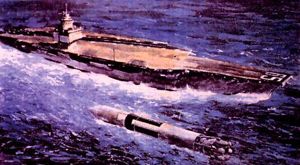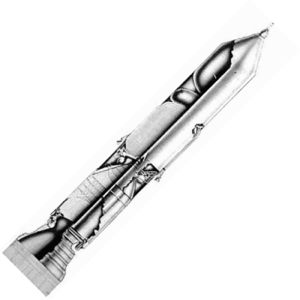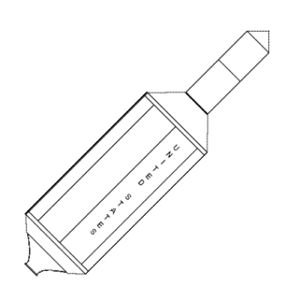
Home - Search - Browse - Alphabetic Index: 0- 1- 2- 3- 4- 5- 6- 7- 8- 9
A- B- C- D- E- F- G- H- I- J- K- L- M- N- O- P- Q- R- S- T- U- V- W- X- Y- Z
Sea Dragon
 Sea Dragon Credit: © Mark Wade |
Status: Design 1962. Payload: 450,000 kg (990,000 lb). Thrust: 350,000.00 kN (78,680,000 lbf). Gross mass: 18,000,000 kg (39,000,000 lb). Height: 150.00 m (490.00 ft). Diameter: 23.00 m (75.00 ft). Apogee: 185 km (114 mi).
The first stage had a single pressure fed, thrust chamber of 36 million kgf thrust, burning LOX/Kerosene. The second stage was ‘considerably smaller' (thrust only 6.35 million kgf!) and burned LOX/LH2. The complete vehicle was 23 m in diameter and 150 m long. The all-up weight was 18,000 metric tons. The launch vehicle would be fuelled with RP-1 kerosene in port, then towed horizontally to a launch point in the open ocean. It would then be filled with cryogenic liquid oxygen and hydrogen from tankers or produced by electrolysis of sea water by a nuclear aircraft carrier (such as the CVN Enterprise in the painting). After fuelling, the tanks at the launcher base would be flooded, and the vehicle would reach a vertical position in the open ocean. Launch would follow. The concept was proven with tests of the earlier Sea Bee and Sea Horse vehicles. Aside from the baseline two-stage expendable version, a single-stage-to-orbit reusable vehicle with a plug nozzle was designed. Costs to low earth orbit were estimated to be between $60/kg and $600/kg - eg one fourth that of the Saturn V or less.
Stage one used liquid nitrogen to force the propellants into the engine. At ignition, combustion chamber pressure was 20 atmospheres, and kerosene was forced into the chamber at a pressure of 32 atmospheres and liquid oxygen at 17 atmospheres. By burnout 81 seconds later combustion chamber pressure had declined to 14 atmospheres, kerosene feed pressure to 20 atmospheres, and liquid oxygen pressure to 8.5 atmospheres. At burnout the stage had reached a velocity of 1.8 km/second at an altitude of 40 km and a range of 33 km. After separation the stage would impact the ocean 290 km downrange (one alternate was recovery and reuse of the stage). Losses due to gravity and drag were minimized by the high 2:1 thrust-to-weight ratio and low drag losses (deceleration at max q was about 0.2 G's ) resulting from the large size of the booster.
Stage two had a burn time of 260 seconds and a low constant combustion chamber pressure of 7 atmospheres. The stage achieved a total delta V of 5.8 km/second, shutting down at orbital velocity at an altitude of 230 km and 940 km downrange from the launch point. A significant feature of the concept was the use of an expandable nozzle exit cone. This increased the area ratio of the nozzle from 7:1 to 27:1 when deployed. Initial tests showed considerable promise, but development ceased because of lack of in-house funding. This concept was later fully developed under the solid rocket Peacekeeper program.
The design was reviewed with Todd Shipyards, who concluded that it was well within their capabilities, and not too unlike making a submarine hull. 8 mm thick maraging steel was used, similar to the Aerojet 260 inch solid motor of the time. NASA Marshall gave the Aerojet designs to TRW for evaluation. TRW fully confirmed Aerojet's costs and engineering, a great surprise to both TRW and NASA. Aerojet was considering purchasing Sudden Ranch as a launch site for Sea Dragon. This property included several kilometers of coastline between Santa Barbara and Vandenberg AFB. This was the only site on the continental United States that could launch directly into a polar orbit without overflying populated areas (and was later incorporated into Vandenberg).
But this came just as Apollo was being cut back and the Viet Nam war was eating an ever greater amount of the US budget. NASA dissolved their Future Projects Branch (dropping almost all the manned Mars landing work). Prospects for Sea Dragon essentially disappeared, and Aerojet could no longer fund it on IR&D.
Many thanks to Mark C Goll for providing some of the materials on which this article was based.
LEO Payload: 450,000 kg (990,000 lb) to a 185 km orbit at 90.00 degrees. Launch Price $: 300.000 million in 1962 dollars.
| Seabee American sea-launched test vehicle. Seabee was a brief proof of principle program to validate the sea-launch concept for Sea Dragon. A surplus Aerobee rocket was modified so that it could be fired underwater. The rocket worked properly the first time in restrained mode. Later tests were made with various approaches to readying the unit for repeat firings. This proved to be so simple that the cost of turn-around was found to be about 7% of the cost of a new unit. |
| Sea Horse American sea-launched test vehicle. The second phase of Sea Launch was to demonstrate the concept on a larger scale, with a rocket with a complex set of guidance and control systems. Sea Horse used one of 39 surplus Corporal missiles that Truax obtained from the Army and successfully demonstrated ignition in the ocean of a rocket stage. |
| Excalibur American sea-launched orbital launch vehicle. Excalibur was a subscale version of Sea Dragon proposed by Truax Engineering in the 1990's. It featured the same attributes as Sea Dragon: low cost design (pressure fed engines), LOx/Kerosene first stage (combustion chamber pressure 24 atmospheres) and LOx/LH2 second stage (chamber pressure 5 atmospheres). Guidance would be by a combined Inertial/GPS system. An even smaller Excalibur S vehicle would prove the concept and place 500 kg in orbit. |
| SEALAR American sea-launched orbital launch vehicle. SEALAR (SEA LAunched Rocket) was yet another attempt by Truax Engineering to get the amphibious-launch concept off the ground. The project received some Navy Research Laboratory funding in the early 1990's, with a planned first launch date of 1996. A production model would have been able to achieve orbit at an estimated cost of $ 10 million per launch. As with the earlier Truax projects, it did not achieve flight test status. |
| Excalibur Model S American sea-launched orbital launch vehicle. Two recoverable pressure-fed stages. |
Family: heavy-lift, orbital launch vehicle, Sea-Launched. People: Truax. Country: USA. Bibliography: 480, 8622.
 | Sea Dragon Credit: Truax Engineering |
 | Sea Dragon Credit: via Mark C Goll |
 | Sea Dragon Credit: via Mark C Goll |
 | Sea Dragon Sea Dragon Launch Vehicle Credit: © Mark Wade |
1961 October 25 - . Launch Site: Point Mugu. LV Family: Sea Dragon. Launch Vehicle: Seabee.
1961 November 2 - . Launch Site: Point Mugu. LV Family: Sea Dragon. Launch Vehicle: Seabee.
1962 - . Launch Vehicle: Sea Dragon.
- Sea Dragon low cost heavy-lift vehicle proposed - .
Nation: USA.
Sea Dragon was a two-stage design capable of putting 550 tonnes into low Earth orbit. The concept was to achieve minimum launch costs through lower development and production costs. This meant accepting a larger booster with a lower performance propulsion system and higher stage dead weight then traditional NASA and USAF designs.
Back to top of page
Home - Search - Browse - Alphabetic Index: 0- 1- 2- 3- 4- 5- 6- 7- 8- 9
A- B- C- D- E- F- G- H- I- J- K- L- M- N- O- P- Q- R- S- T- U- V- W- X- Y- Z
© 1997-2019 Mark Wade - Contact
© / Conditions for Use